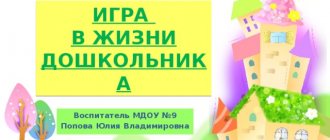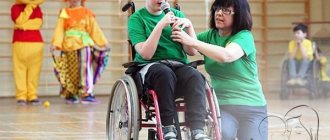“Preserving and strengthening the health of children in preschool educational institutions”
Preserving and strengthening the health of children in preschool educational institutions
Raising a healthy child is one of the most important tasks of a family and preschool institution.
Health is not only the absence of disease or physical defects, but also complete physical, mental and social well-being. It is the most important indicator that reflects the biological characteristics of the child, the conditions of upbringing, education of children, their life in the family, the quality of the environment, the degree of development of medical care, maternal and child health services, and ultimately the state’s attitude to health problems.
In a preschool educational institution, the primary task is to protect and strengthen the health of children. The work of teachers is aimed at maintaining a cheerful, cheerful mood in the child, preventing negative emotions and nervous breakdowns; improvement of all body functions, full physical development, nurturing interest in various available types of motor activity, forming the foundations of physical culture, the need for daily physical exercise, nurturing positive moral and volitional qualities.
Physical education in a preschool educational institution is carried out both in
special physical education classes, and in play activities and in the daily life of children, in various forms of organizing motor activity .
Favorable sanitary and hygienic conditions are created in the kindergarten, a daily routine is observed, and caring care is provided for each child based on a person-oriented approach; nutritious meals and daily exposure to fresh air are provided; Tempering activities and morning exercises are systematically carried out at all times of the year, and if appropriate conditions are available, swimming lessons are organized for children. In all age groups, much attention is paid to developing correct posture in children.
The expansion of the child’s individual motor experience, consistent learning of movements and motor actions: correct, rhythmic, easy walking, running, the ability to jump from a place and with a running start, various types of throwing, climbing, movements with balls, do not go unnoticed. Children are taught to clearly, rhythmically, and at a certain pace perform various physical exercises by demonstration and based on verbal descriptions; the learned movements are performed to music.
Educators create an environment in a preschool institution that is conducive to the development of personal hygiene skills. Children are taught to understand the value of a healthy lifestyle, to take care of their health, and are introduced to the basic rules of safe behavior.
Various types of hardening procedures are systematically carried out under the guidance of a medical professional, taking into account the individual characteristics of children.
Morning exercises are held daily
in a ventilated area.
During organized educational activities that require a lot of mental stress, and in the intervals between them, physical education sessions lasting 1-3 minutes are held.
In a preschool institution, the leading activity is play
. In order to prevent overwork in preschool educational institutions, traditional classes are replaced by complex ones, which are conducted in a playful way.
Teachers provide sufficient age-appropriate motor activity for children throughout the day, using outdoor activities, sports, folk games and physical exercises.
Every month there are physical training exercises and holidays
.
At the present stage, the task of our society is to educate healthy, harmoniously developed people with high mental and physical performance. To successfully solve this problem, it is important, as they say, to “take care of your health from a young age.” This means that it is necessary to strengthen the child’s health from the first days of his life.
An effective means of promoting health, reducing morbidity and increasing the level of performance of children is hardening the body. Sun, air and water are factors whose systematic exposure increases the body’s resistance to changing weather conditions.
Hardening
– this is not only wiping or dousing, but also everyday ordinary procedures that do not require special organization or additional time: staying indoors and outdoors in appropriate clothing, washing with cool water, sleeping with an open vent or window, active physical exercise.
Air acts as a complex irritant, enhancing metabolic processes, increasing the amount of hemoglobin and red blood cells, strengthening the nervous system. Its beneficial effect is also manifested in the child’s mood - he becomes cheerful and cheerful. It is necessary to use fresh air for hardening purposes constantly, at any time of the year. Cold winter air in combination with active physical exercise and games has a particularly beneficial effect. For the proper development of a child, it is important that he is exposed to the air for 4-5 hours in winter, and almost all day in summer. When organizing outdoor walks for children, adults should create conditions for their active activities.
A good way to improve health is water hardening.
Children love to play with her; Such activities improve the mood and evoke joyful emotions in the child. This should be used to improve the health of the body. It is better to start water procedures in the warm season. Wash the children with cool water. First, wash your hands up to your elbows, then your neck and face.
One of the effective methods of hardening is contrasting dousing of the feet: first with cold water - 24-25 degrees, then warm - 36 degrees and again cold.
The most powerful healing and hardening remedy is swimming in a pond. For a healthy child, it is permissible from the age of 2 years at an air temperature of 25 - 28 degrees and a water temperature of at least 22 degrees.
It must be remembered that the hardening effect of the applied influences depends on the systematicity, continuity of use, gradually increasing intensity of the procedures, and taking into account the individual sensitivity of the child.
If measures to improve a child’s health, carried out in kindergarten, are complemented by daily exercises and outdoor games in a family environment, he develops individual inclinations and interests. Children are especially susceptible to the beliefs, positive behavior of their father, mother, and family lifestyle. Therefore, the educator needs to improve the methods of pedagogical propaganda among parents, to involve them in the active pedagogical process, so that the knowledge they acquire is embodied in the specific work of raising children.
Of great importance in the process of developing good posture are a strictly observed daily routine, the size of furniture, and the posture of children during organized educational activities, labor and other types of independent activities.
Morning exercises are one of the most important components of children’s motor regimen. It is aimed at improving the health, strengthening, increasing the functional level of body systems, developing the physical qualities and abilities of children, and consolidating motor skills. The need to start doing morning exercises after waking up develops the child’s volitional qualities: will, perseverance, discipline, perseverance, independence.
Morning exercises are also valuable because children develop the habit of performing various exercises every day in the morning. Over time, this useful habit turns into a need and remains with the person for life.
After intense physical activity, breathing exercises are necessary to restore breathing. In preschool children, the respiratory muscles are weak, so breathing exercises are very useful. They promote full physical development and prevent diseases of the respiratory system.
Early childhood is a period of intense physical and mental development. It is at this age that the mental and moral development of a child especially depends on his physical condition and mood.
Preschool education plays a significant role in creating conditions for the harmonious development of a person, which is impossible without physical education.
To this end, to make physical education classes interesting and exciting for children, teachers develop a variety of entertaining elements aimed at activating children’s motor activity, developing dexterity and coordination.
The great value of every person is health.
Raising a child strong, strong, and healthy is the desire of parents and one of the leading tasks facing a preschool institution.
The joint activities of teachers - children - parents allows:
- increase the efficiency of work on children's health;
- obtain the necessary knowledge about the physical development of the child;
- create a need for a healthy lifestyle in your family;
- reduce the “deficit” of positive emotions in children, create a festive atmosphere during joint sports activities;
- see and learn about the work of a kindergarten on the physical development of children;
- to ensure continuity of methods and techniques of raising children in the family and in kindergarten.
Many years of experience in such work show that the results of physical education and sports are high when there is interaction between the family and the kindergarten.
Working together helps to strengthen and preserve the child’s health, develop his strength and endurance, physical abilities, and increase his body’s resistance to disease.
It is necessary to teach children from an early age:
- safety at home;
- the ability and desire to be neat and tidy;
- introduce the rules of communication with animals;
- develop road behavior skills;
- cultivate caution in communication;
- establish rules of behavior on the water and in public;
- develop aesthetic taste.
Only the professional competence of teachers of a preschool educational institution, love for their profession and, of course, for children, contribute to the preservation and strengthening of children’s health. Children are the future of our society. And, therefore, their well-being depends on us.
Physical education classes
Health improvement of a child in a preschool educational institution
necessarily includes physical exercise. These or other types of exercises are selected by the physical work teacher, taking into account the age of the children.
Thus, in younger groups, the main goal of classes is to teach children to navigate in space and work with simple sports equipment and equipment. In middle groups, classes are more focused on the development of physical qualities - strength, endurance, agility. In older children, they instill the need for active movement, teach independence, organization and group work.
Any physical activity should, first of all, bring joy to the child. Therefore, the correct methods for improving the health of children in kindergarten are always varied. These are not only traditional gymnastic and sports exercises, but also outdoor games of varying intensity, rhythmic exercises, competitions and relay races, story-based exercises and much more.
Hardening
Health improvement for children in kindergarten
impossible without hardening procedures. When working with children, it is important to follow the key principles of hardening:
- carry out hardening procedures only with healthy children;
- refuse hardening if the child reacts negatively to it - cries, worries, is afraid;
- start with gentle procedures, gradually moving to more intense ones;
- carry out hardening regularly and systematically.
In a kindergarten, a medical worker must keep a hardening notebook, where the procedures performed, the children’s reaction, the results achieved and available medical outlets will be noted.
Basic hardening techniques, which include health improvement work in a preschool educational institution
:
- extensive washing with cool water. The child alternately runs wet palms over both arms from the hand to the elbow, then over the neck, upper chest and face, after which he wipes himself dry;
- daytime sleep without T-shirts - this procedure can be carried out in the warm season;
- rinsing the mouth with an iodine-salt solution (3-5 drops of iodine and a tablespoon of salt per 1 liter of water at room temperature), recommended after exercise or napping;
- walking barefoot;
- the so-called “Riga technique” - walking on a mat with rubber spikes soaked in saline solution.
Preventive actions
Health of preschool children
is also supported by a set of preventive measures aimed at preventing colds and other diseases. Such measures include sets of visual exercises to prevent myopia, gymnastics with the simplest elements of yoga, breathing exercises, sleeping without pillows, self-massage of the earlobes and auricles.
During training sessions, pauses are required for relaxation, breathing and vision training. Particular attention is paid to the optimal motor mode, which is the best prevention of flat feet and postural disorders.
Finally, the preservation of the health of children in preschool educational institutions is ensured through the organization of a high-quality and safe environment. This, first of all, includes regular wet cleaning of kindergarten premises, ventilation, and maintaining optimal temperature conditions. Rooms where children play and sleep should receive sufficient natural light. In the autumn-winter period, as well as in the northern regions, the lack of natural light can be compensated by installing fluorescent lamps.
Physical education classes may be accompanied by music. A musical background promotes better coordination of movements, improves mood and stimulates children's activity.


